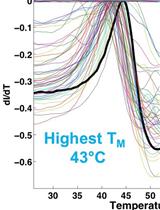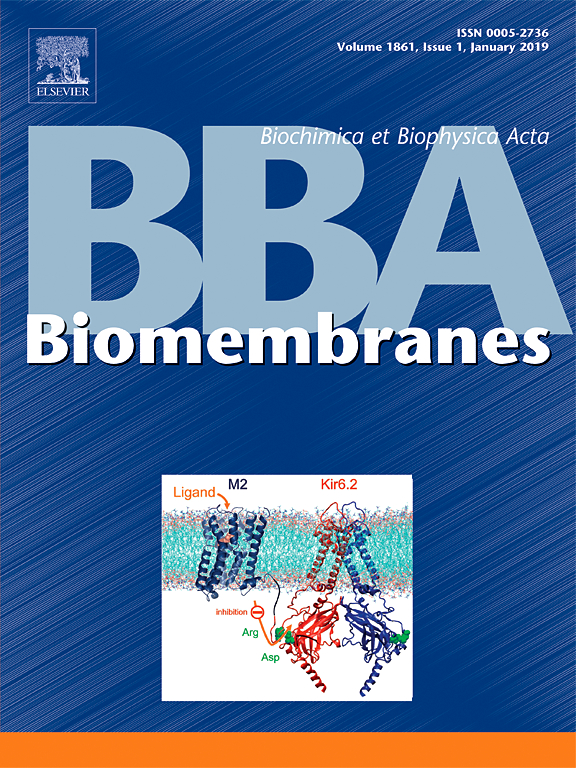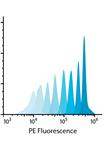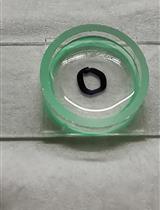- EN - English
- CN - 中文
In vitro Membrane Interaction and Liposome Fusion Assays Using Recombinant Hepatitis C Virus Envelope Protein E2
利用重组丙型肝炎病毒包膜蛋白E2体外检测膜互作和脂质体融合
(*contributed equally to this work) 发布: 2018年12月05日第8卷第23期 DOI: 10.21769/BioProtoc.3108 浏览次数: 5625
评审: David PaulJan-Ulrik DahlAli Asghar Kermani

相关实验方案

用热荧光法鉴定疱疹病毒蛋白UL37的最佳热稳定性和溶解度的缓冲液条件
Andrea L. Koenigsberg [...] Ekaterina E. Heldwein
2020年06月20日 3742 阅读
Abstract
In order to study the mechanism underlying the Hepatitis C Virus (HCV) fusion process we have performed assays using phospholipid liposomes and a truncated form of E2 protein, E2661 (amino acids 384-661 of the HCV polyprotein) lacking the transmembrane region. E2661 has been previously generated by using the baculovirus expression system. This form has been used in lipid-protein interaction studies with different model vesicles at different pHs, and monitored using a variety of fluorescent assays. After the analysis of the results, we observed that E2661 is able to insert into lipid bilayers and to induce vesicle aggregation, lipid mixing and liposome leakage, showing higher values of membrane destabilization for negatively charged phospholipids at acidic pH. This is indicative of the role of E2 glycoprotein in the HCV initial infective steps, interacting with the target membranes and producing their destabilization.
Keywords: Hepatitis C virus (丙型肝炎病毒)Background
The fusion of the viral and cellular membranes is the first step of the infective cycle of an enveloped virus (Lemon et al., 2007; Lindenbach et al., 2007). This fusion can take place either at the plasma membrane or in an intracellular location after viral internalization by endocytosis mediated by binding to a receptor located at the plasma membrane. The Hepatitis C virus (HCV) genome is translated into a single large polyprotein, which is processed, among others, into the envelope proteins E1 and E2, which are involved in membrane fusion of this virus with the hepatocyte membranes. E1 (residues 192-383 of the polyprotein) and E2 (residues 384-746) are type-I transmembrane proteins, highly glycosylated, with an N-terminal, water soluble, ectodomain and a C-terminal hydrophobic domain anchoring these glycoproteins to the membrane. Sequence comparisons with fusion proteins of other viruses suggest that E2 could be the fusion protein (Cormier et al., 2004; Rocha-Perugini et al., 2008). However, several studies performed with synthetic peptides suggest the involvement of both E1 and E2 ectodomain sequences in the fusion process. To increase our knowledge of HCV biology two approaches have been developed: the use of HCV pseudoparticles (HCVpp), which consist of E1E2 glycoproteins assembled with retroviral core particles (Lavillette et al., 2006; Meertens et al., 2006), and a more recent cell culture model which enables the propagation of virus in cell culture (HCVcc) (Koutsoudakis et al., 2006). However, these systems are difficult to study fusion in vitro and the results obtained do not indicate which of the two glycoproteins has the fusogenic properties. To advance in the knowledge of HCV fusion mechanism, we have studied the membrane-perturbing properties of the ectodomain of E2, obtained using a baculovirus expression system, by employing a variety of fluorescent assays and different conditions (pH and phospholipid composition). We have previously shown that E2661 is folded as an independent unit and is recognized by HCV patient sera antibodies (Rodriguez-Rodriguez et al., 2009). Our study shows that E2661 is able to induce the essential steps required for fusion (Rodriguez-Rodriguez et al., 2018).
Materials and Reagents
- Pipette tips
- Pyrex borosilicate glass tubes (Corning, catalog numbers: 99445-10 [10 x 75 mm] and 99445-13 [13 x 100 mm])
- 100 nm polycarbonate filters (Whatman, catalog number: 800309)
- Absorption and fluorescence cuvettes (Hellma, absorption cuvette 1 x 0.2, catalog number: QS 104-10-40; fluorescence cuvette 1 x 0.2, catalog number: 104002F-10-40; fluorescence cuvette 1 x 0.4, catalog number: 104F-10-40)
- Glass column manually made by faculty glass blower facility
- Sephadex G-75 (Pharmacia Biotech, catalog number: 17-0051-01)
- Chloroform (Scharlau, catalog number: CL02001000)
- Methanol (Merck, catalog number: 106002)
- Dimyristoylphosphatidylcholine (DMPC) (Avanti Polar Lipids, catalog number: 850345)
- Dimyristoylphosphatidylglycerol (DMPG) (Avanti Polar Lipids, catalog number: 840445)
- Egg phosphatidylcholine (PC) (Avanti Polar Lipids, catalog number: 840051)
- Egg yolk phosphatidylglycerol (PG) (Sigma-Aldrich, catalog number: 50445)
- Nitrogen Gas (Carburos metálicos, catalog number: UN1066)
- Tris-Base (Sigma-Aldrich, catalog number: T1503)
- NaCl (Merck, catalog number: 106404)
- 2-Morpholinoethanesulfonic acid monohydrate buffer substance MES (Merck, catalog number: 106126)
- Sodium citrate (Merck, catalog number: 106448)
- EDTA (Sigma-Aldrich, catalog number: 03695)
- N-(7-nitro-2,1,3-benzoxadiazol-4-yl)dimyristoylphosphatidylethanolamine (NBD-PE) (Avanti Polar Lipids, catalog number: 810143)
- N-(lissaminerhodamine B sulfonyl)diacylphosphatidyl-ethanolamine (Rh-PE) (Avanti Polar Lipids, catalog number: 810157)
- 8-aminonaphthalene-1,3,6-trisulfonic acid (ANTS) (Thermo Fisher Scientific, InvitrogenTM, catalog number: A350)
- p-xylenebis-(pyridinium) bromide (DPX) (Thermo Fisher Scientific, InvitrogenTM, catalog number: X1525)
- Liquid nitrogen (Air Liquide, Spain)
- Triton X-100 (USB, catalog number: 22686)
- Tetrahydrofuran (Sigma-Aldrich, catalog number: 401757)
- 1,6-diphenyl-1,3,5-hexatriene (DPH) (Sigma-Aldrich, catalog number: D208000)
- 1-(4-trimethylammoniumphenyl)-6-phenyl-1,3,5-hexatriene (TMA-DPH) (Sigma-Aldrich, catalog number: T0775)
- Medium buffer (see Recipes)
Equipment
- Pipettes: volume ranges of 2-20 μl, 20-200 μl and 200-1,000 μl
- Speed Vac (Uniequip, model: Univapo 100 H)
- Water bath Incubator (Selecta, model: unitronic 320)
- Bath sonicator (Bransonic, model: Branson 1200)
- Extruder apparatus (Avestin, model: LiposoFastTM-Basic)
- Spectrophotometer (Beckman Coulter, model: Beckman DU-640)
- Spectrofluorometer, equipped with a thermostated cell holder in which the temperature of the cuvette is maintained by a circulating water bath (SLM Aminco, model: SLM Aminco 8000C)
Procedure
文章信息
版权信息
© 2018 The Authors; exclusive licensee Bio-protocol LLC.
如何引用
Yélamos, B., Rodríguez-Rodríguez, M., Gavilanes, F. and Gómez-Gutiérrez, J. (2018). In vitro Membrane Interaction and Liposome Fusion Assays Using Recombinant Hepatitis C Virus Envelope Protein E2. Bio-protocol 8(23): e3108. DOI: 10.21769/BioProtoc.3108.
分类
生物化学 > 蛋白质 > 荧光
您对这篇实验方法有问题吗?
在此处发布您的问题,我们将邀请本文作者来回答。同时,我们会将您的问题发布到Bio-protocol Exchange,以便寻求社区成员的帮助。
提问指南
+ 问题描述
写下详细的问题描述,包括所有有助于他人回答您问题的信息(例如实验过程、条件和相关图像等)。
Share
Bluesky
X
Copy link










